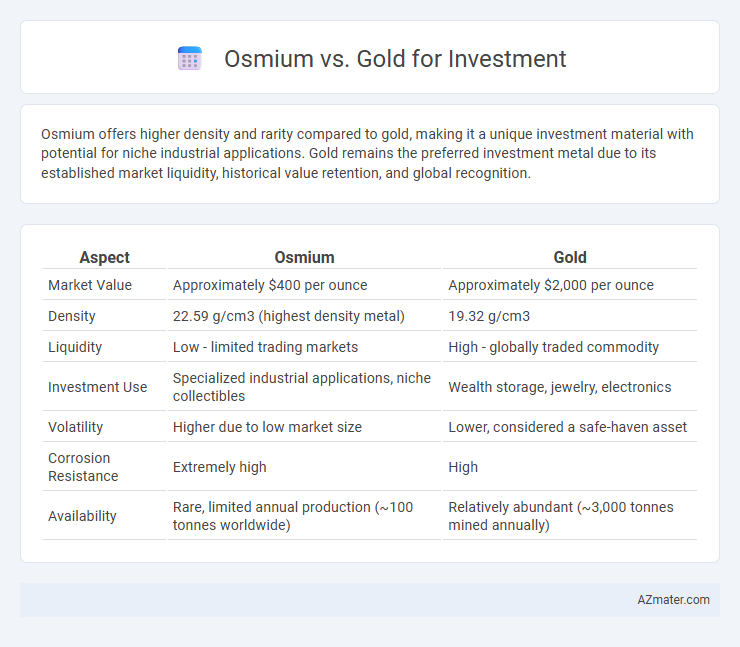Osmium offers higher density and rarity compared to gold, making it a unique investment material with potential for niche industrial applications. Gold remains the preferred investment metal due to its established market liquidity, historical value retention, and global recognition.
Table of Comparison
| Aspect | Osmium | Gold |
|---|---|---|
| Market Value | Approximately $400 per ounce | Approximately $2,000 per ounce |
| Density | 22.59 g/cm3 (highest density metal) | 19.32 g/cm3 |
| Liquidity | Low - limited trading markets | High - globally traded commodity |
| Investment Use | Specialized industrial applications, niche collectibles | Wealth storage, jewelry, electronics |
| Volatility | Higher due to low market size | Lower, considered a safe-haven asset |
| Corrosion Resistance | Extremely high | High |
| Availability | Rare, limited annual production (~100 tonnes worldwide) | Relatively abundant (~3,000 tonnes mined annually) |
Introduction to Osmium and Gold as Investment Options
Osmium, a rare and dense platinum-group metal, offers unique investment potential due to its scarcity and industrial applications in electronics and catalysts. Gold remains a traditional safe-haven asset, prized for its liquidity, global recognition, and ability to hedge against inflation and currency fluctuations. Comparing osmium to gold involves assessing osmium's limited market and higher volatility against gold's stable demand and established trading infrastructure.
Historical Performance: Osmium vs Gold
Gold has demonstrated consistent historical performance as a traditional safe haven asset, maintaining value during economic downturns and geopolitical instability, with an average annual return of about 1-2% above inflation over the last century. Osmium, a rare and dense platinum-group metal, lacks extensive market history and liquidity, resulting in limited performance data and higher price volatility in comparison to gold. Investors favor gold for its well-established market infrastructure, while osmium remains a niche asset with potential but uncertain historical investment reliability.
Rarity and Supply: Comparing Osmium and Gold
Osmium is one of the rarest and densest naturally occurring elements with an estimated global production of just a few hundred kilograms annually, significantly lower than gold's annual supply of around 3,000 metric tons. The scarcity of osmium is amplified by its limited industrial use and complex extraction process, whereas gold benefits from a well-established global supply chain and extensive recycling networks. Investors considering rarity and supply factors find osmium's extreme scarcity promising for potential value appreciation, but gold remains more accessible and liquid due to its widespread availability and demand.
Market Liquidity and Accessibility
Osmium's market liquidity is significantly lower than gold's due to its niche industrial applications and limited investor demand, resulting in fewer buyers and sellers and less frequent trading. Gold's extensive global market infrastructure, including numerous exchanges and widely accepted bullion products, ensures high liquidity and ease of access for both retail and institutional investors. Accessibility to osmium is constrained by its rarity, high cost of extraction, and lack of standardized investment vehicles, whereas gold benefits from well-established markets and a variety of accessible formats such as coins, bars, and ETFs.
Price Volatility and Stability
Osmium exhibits higher price volatility compared to gold due to its limited market liquidity and rarity in investment portfolios, which can lead to sharp price fluctuations. Gold is recognized for its price stability, benefiting from widespread acceptance, extensive trading volume, and its status as a global reserve asset. Investors seeking stable value preservation typically prefer gold, while osmium attracts those with a higher risk tolerance aiming for potential high returns in niche markets.
Storage and Security Considerations
Osmium's high density and brittleness require specialized, secure storage solutions to prevent damage and theft, contrasting with gold's more standardized, widespread storage infrastructure. Gold benefits from established vaulting systems globally, making it easier to insure and transport compared to osmium, which demands customized containment due to its toxicity and fragility. Investors must weigh osmium's unique handling risks against gold's proven security protocols when considering long-term asset protection.
Industrial Applications and Demand Drivers
Osmium's industrial applications center on its use in fountain pen tips, electrical contacts, and as a catalyst in chemical reactions due to its density and hardness, creating niche demand in specialized manufacturing sectors. Gold's widespread use in electronics, dentistry, and aerospace consistently drives global industrial demand, bolstered by its excellent conductivity and corrosion resistance. While gold's industrial demand is supported by steady market liquidity and investment appeal, osmium's limited supply and specialized application create sporadic but high-value industrial interest.
Legal and Regulatory Aspects
Osmium investment faces stricter legal and regulatory scrutiny compared to gold due to its rarity and classification under hazardous material guidelines in many jurisdictions. Gold benefits from well-established regulations, standardized trading platforms, and widespread acceptance as a secure asset globally. Investors must navigate complex import-export controls and stringent environmental laws when dealing with osmium, increasing compliance costs and limiting market liquidity.
Risks and Challenges in Investing
Osmium presents significant risks due to its extreme rarity, high price volatility, and limited market liquidity compared to gold, which is widely recognized and traded globally with established regulatory frameworks. The physical handling of osmium requires caution because of its toxic osmium tetroxide compound, creating storage and transport challenges. Gold offers greater investment security through its stable demand, historical value retention, and ease of trade, whereas osmium investments face uncertainties from scarce market data and potential legal restrictions.
Future Prospects: Osmium vs Gold
Osmium's future investment prospects hinge on its rarity, industrial applications, and growing demand in specialized markets like electronics and catalysis, which could drive its value higher over time. Gold remains a stable investment due to its long-standing role as a hedge against inflation and economic uncertainty, maintaining consistent demand worldwide. Investors should weigh osmium's emerging potential against gold's proven track record in portfolio diversification and wealth preservation.

Infographic: Osmium vs Gold for Investment
 azmater.com
azmater.com